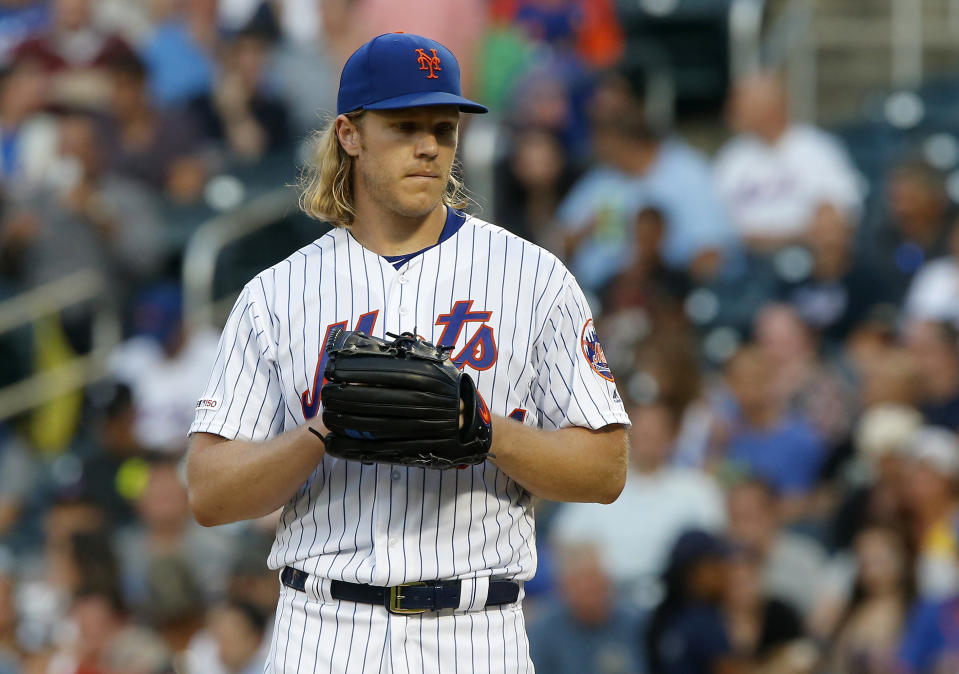Pitching the name of the game heading into MLB's trade deadline
If the past few winters have revealed little else, it is that the game lacks the stomach for mediocrity. Or make that, perhaps, inevitable mediocrity. Planned mediocrity. That leaves winning, or trying to win, which is where the money is. And it allows for rebuilding or tanking or whatever today’s idiom is, which is where the alibis are. (And where the money is.)
The rest is a clock-punching slog dressed up as second wild-card ambition and Mike Trout highlights. Nobody shoots for mediocrity as a place to hang out until the Double-A cavalry arrives, assuming it’s headed this way at all, except here we are, a third of Major League Baseball there anyway, selling hope and $25 parking spaces in the name of “meaningful games in September.”
It is, of course, just this sort of accidental relevance that fuels and complicates the final days of July and a trade deadline in which the winners are expected to deal away potential prospects for the players they wouldn’t sign in the winter because of the cost in draft picks, so potential prospects. And the rebuilders (and tankers) are expected to send their best players to the New York Yankees for what is safely assumed to be the next Mickey Mantle. The rest, the accidentally relevant, are supposed to choose between selling out and buying in based on the results of, like, four late-July games played against other equally adventitious souls. General managers will make these decisions and the subsequent deals -- or non-deals -- with great confidence. They will, by and large, be guessing.
Anyway, this is basically the system that had Yu Darvish pitching for the Los Angeles Dodgers in Game 7 of a World Series and Steve Pearce driving in three runs for the Boston Red Sox against the Dodgers in Game 5 of the next World Series, that has Fernando Tatis Jr. growing up in San Diego and not Chicago and Chris Paddack growing up in San Diego and not Miami and why, otherwise, the Padres should hardly ever make trades.
The point being, somebody -- the Dodgers, Yankees, Houston Astros, Minnesota Twins, Atlanta Braves, somebody -- is likely to acquire a pitcher or position player of some impact and win a World Series partly as a result. That pitcher could be Marcus Stroman or Zack Greinke or Madison Bumgarner or Noah Syndergaard. That position player could be Charlie Blackmon or Nick Castellanos or Jose Abreu or, outside the Dodgers, Yasiel Puig. Already, the Red Sox have acquired Andrew Cashner (7.36 ERA in two starts), the Oakland A’s have acquired Homer Bailey (12.38 ERA in two starts) and the Chicago Cubs have acquired Martin Maldonado (.000 batting average in four games.) Also, the Dodgers traded for Tyler White and if recent history holds he’ll be the right-handed Max Muncy in about three weeks. And everyone else will hope they aren’t about to trade away Tatis Jr. for what becomes a few months of ordinary baseball.

Basically, in this version of the trade deadline, everyone needs or thinks they need pitching, so that is what lies ahead -- 23 teams of winners and contenders and loiterers seeking to improve their pitching staffs on the backs of the seven terrible teams, give or take a couple, all that subject to change based on results from the coming several days.
Where it gets interesting is in, of course, New York, where the early assessment is that rookie general manager Brodie Van Wagenen is asking for massive returns on Syndergaard and reliever Edwin Diaz, in particular, because his first trades (for Edwin Diaz, for example) don’t look good today. And in, say, San Francisco, where the awful Giants have been positively even-year-ish in July. Farhan Zaidi, in his first season as general manager there, suddenly must deal with wild-card semi-relevance in addition to nursing the final season of manager Bruce Bochy and the pending free agencies of organizational legend Bumgarner and closer Will Smith and, perhaps, a gnawing belief the Dodgers probably won’t be beaten. The industry sense is he’ll move Smith to one of the many clubs (all of them) who could use a reliever (the Atlanta Braves, Philadelphia Phillies, St. Louis Cardinals, Tampa Bay Rays and Twins, among others, including the Dodgers, need help), and hold onto Bumgarner. Unless, of course, Zaidi pauses what could be an arduous rebuild of an aging team, gets sentimental about one more run for good ol’ Boch, can’t bring himself to move Bumgarner for a couple mid-level prospects when Bumgarner would bring a compensatory draft pick (as a condition of a qualifying offer) anyway, and buys into another two (or three) months of accidental relevance by adding a pitcher and an outfielder.
Yes, the Mets are interesting for the next test of Van Wagenen, and a market dying for starting pitching. The Milwaukee Brewers, for one, already had one of the least effective rotations in the National League, then had Brandon Woodruff strain an oblique and now there are too many games and not enough starters. The Yankees are the best team in the American League and have two starters with ERAs under 4 ½. There are young starting pitchers all over the league who soon will bump up against innings limits, and maybe the smartest moves of the summer were by the Braves, who signed Dallas Keuchel in June, and the Cubs, who signed Craig Kimbrel the day prior. Both were winter hold-overs because, of course, no one wanted to gain a good veteran pitcher if the price was a prospect, which brings us back to today, and the search for the next Fernando Rodney-for-Chris Paddack shellacking.
More from Yahoo Sports:


